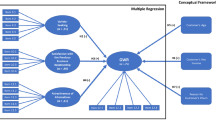Abstract
Customer relationship management seeks to understand how to generate profitable customers who enter into a long-term relationship with a firm. In this paper, we examine the role of modes of acquisition and retention programmes on customer lifetime in the context of a credit card issuing bank. While other papers have studied retention programmes such as loyalty card and reward card, there is no published study in the credit card context. Using a rich data set on nearly 5,000 customers observed over a three-year period, we are able to provide detailed insights about the efficacy of these strategies. We show that affinity cards customers and customers acquired through direct mail have longer lifetimes. We also find that reward card programmes generate customers with a shorter lifetime. Finally we re-examine the link between long-life customers and profitability and find that the relationship is weak, consistent with recent findings.
Similar content being viewed by others
References
Reichheld, F. F. and Teal, T. (1996) ‘The Loyalty Effect’, Bain and Company, Inc, Boston, MA.
Mulhern, F. (1999) ‘Customer profitability analysis: Measurement, concentration and research directions?’ Journal of Interactive Marketing, Vol. 13, No. 1, pp. 25–40.
Zeithaml, V. (2000) ‘Service quality, profitability, and economic worth of customers: What we know and what we need to learn’, Academy of Marketing Science Journal, Vol. 28, No. 1, pp. 67–85.
Zeithaml, V., Rust, R. and Lemon, K. (2001) ‘The customer pyramid: Creating and serving profitable customers’, California Management Review, Vol. 43, No. 4, pp. 118–142.
Reinartz, W. J. and Kumar, V. (2000) ‘On the profitability of long-life customers in a noncontractual setting: An empirical investigation and implications for marketing’, Journal of Marketing, Vol. 64 (October), pp. 17–35.
Uncles, M. D., Dowling, G. R. and Hammond, K. (2003) ‘Customer loyalty and customer loyalty programs’, Journal of Consumer Marketing, Vol. 20, No. 4, pp. 294–316.
Campbell, D. and Frei, F. (2004) ‘The persistence of customer profitability: Empirical evidence and implications from a financial services firm’, Journal of Services Research, Vol. 7, No. 2, pp. 107–123.
Garland, R. (2005) ‘Segmenting retail banking customers’, Journal of Financial Services Marketing, Vol. 10, No. 2, pp. 179–191.
Malester, J. (2005) ‘Sirius reported higher revenue, soaring subscriptions during Q4’, This Week in Consumer Electronics, Vol. 20, No. 4, p. 12.
Meyer, D. (2005) ‘Carriers must reduce acquisition costs to make thrifty customers profitable’, RCR Wireless News, Vol. 24, No. 10, p. 14.
Sherman, J. (2005) ‘DirecTV results raise concerns’, Television Week, Vol. 24, No. 5, p. 18.
Verhoef, P. C. and Donkers, B. (2005) ‘The effect of acquisition channel on customer loyalty and cross buying’, Journal of Interactive Marketing, Vol. 19, No. 2, pp. 31–43.
Blattberg, R. C. and Deighton, J. (1996) ‘Manage marketing by the customer equity test’, Harvard Business Review, Vol. 74, No. 4, pp. 136–144.
Murphy, J. A. (1996) ‘Retail banking’, in Buttle, F. (ed) ‘Relationship Marketing: Theory and Practice’, Paul Arapmen Publishing, London, pp. 74–90.
Bolton, R. A., Kannan, P. K. and Bramlett, M. D. (2000) ‘Implications of loyalty program membership and service experiences for customer retention and value’, Journal of the Academy of Marketing Science, Vol. 28, No. 1, pp. 95–108.
Schmittlein, D., Morrison, D. and Colombo, R. (1987) ‘Counting your customers: Who are they and what will they do next?’ Management Science, Vol. 33 (January), pp. 1–24.
Schmittlein, D. and Peterson, R. A. (1994) ‘Customer base analysis: An industrial purchase process application’, Marketing Science, Vol. 13, No. 1, pp. 41–67.
Reinartz, W. J. and Kumar, V. (2003) ‘The impact of customer relationship characteristics on profitable lifetime duration’, Journal of Marketing, Vol. 67 (January), pp. 77–99.
Reichheld, F. F. and Sasser, W. E. (1990) ‘The hidden advantages of customer retention’, Journal of Retail Banking, Vol. 13, No. 4, pp. 19–23.
Morgan, R. M. and Hunt, S. D. (1994) ‘The commitment-trust theory of relationship marketing’, Journal of Marketing, Vol. 58 (July), pp. 30–37.
Sheth, J. N. and Parvatiyar, A. (1995) ‘Relationship marketing in consumer markets: Antecedents and consequences’, Journal of the Academy of Marketing Science, Vol. 23, No. 4, pp. 255–271.
Rosenberg, L. J. and Czepiel, J. A. (1984) ‘A marketing approach to customer retention’, Journal of Consumer Marketing, Vol. 1, No. 2, pp. 45–51.
Rust, R. T. and Zahorik, J. T. (1993) ‘Customer satisfaction, customer retention, and market share’, Journal of Retailing, Vol. 69 (Summer), pp. 193–215.
Dowling, G. R. and Uncles, M. (1997) ‘Do customer loyalty programs really work?’ Sloan Management Review, Vol. 38 (Summer), pp. 71–82.
Thomas, J. S. (2001) ‘A methodology for linking customer acquisition to customer retention’, Journal of Marketing Research, Vol. 38 (May), pp. 262–268.
Blattberg, R. C., Getz, G. and Thomas, J. S. (2001) ‘Customer Equity: Building and Managing Relationships as Valued Assets’, Harvard Business School Press, Boston, MA.
Mathews, H. L. and Slocum, J. W. (1969) ‘Social class and commercial bank credit card usage’, Journal of Marketing, Vol. 33 (January), pp. 71–78.
Plummer, J. (1971) ‘Life cycle patterns and commercial bank credit card usage’, Journal of Marketing, Vol. 35 (April), pp. 35–41.
Adcock, W. O., Hirschman, E. C. and Goldstucker, J. (1977) ‘Bank card users: An updated profile’, in Perrault, Jr. W. D. (ed) ‘Advances in Consumer Research’, Vol. 4, Association for Consumer Research', Atlanta, pp. 236–241.
Garland, R. (2003) ‘Share of wallet's role in customer profitability’, Journal of Financial Services Marketing, Vol. 8, No. 3, pp. 259–268.
Hamilton, R. and Howcroft, J. B. (1995) ‘A practical approach to maximizing customer retention in the financial services industry’, Journal of Marketing Management, Vol. 11, pp. 151–163.
Bolton, R. A., Lemon, K. N. and Verhoef, P. C. (2004) ‘The theoretical underpinnings of customer asset management: A framework and propositions for future research’, Journal of the Academy of Marketing Science, Vol. 32, No. 3, pp. 271–292.
Shankar, V., Smith, A. K. and Rangaswamy, A. (2003) ‘Customer satisfaction and loyalty in online and offline environments’, International Journal of Research in Marketing, Vol. 20, No. 2, pp. 153–176.
Keane, T. J. and Wang, P. (1995) ‘Applications for the lifetime value model in modern newspaper publishing’, Journal of Direct Marketing, Vol. 9, No. 2, pp. 59–66.
Guadagni, P. and Little, J. D. C. (1983) ‘A Logit model of brand choice calibrated on scanner data’, Marketing Science, Vol. 2, pp. 203–238.
Worthington, S. and Horne, S. (1995) ‘Alumni affinity credit cards: Making the relationship work’, International Journal of Bank Marketing, Vol. 13, No. 5, pp. 24–30.
Worthington, S. and Horne, S. (1993) ‘Charity affinity credit cards — Marketing synergy for both card issuers and charities?’ Journal of Marketing Management, Vol. 9, pp. 301–313.
Schlegelmilch, B. B. and Woodruffe, H. (1995) ‘A comparative analysis of the affinity card market in the USA and the UK’, International Journal of Bank Marketing, Vol. 13, No. 5, pp. 12–23.
Worthington, S. (2001b) ‘The affinity card and relationship marketing’, International Journal of Retail and Distribution Management, Vol. 29, No. 11, pp. 493–502.
Credit Card Management. (2001) ‘Loyalty theater: Cobranding 10 years after’, Credit Card Management, Vol. 14 (April), pp. 42–50.
Lee, W. A. (2004) ‘Report: Rewards in majority of offers’, American Banker, Vol. 169, No. 127, p. 6.
Heskett, J. L., Sasser, W. E. and Schlesinger, L. A. (1997) ‘The Service Profit Chain: How Leading Companies Link Profit and Growth to Loyalty, Satisfaction, and Value’, The Free Press, New York, NY.
Meyer-Waarden, L. (2007) ‘The effects of loyalty programs on customer lifetime duration and share of wallet’, Journal of Retailing, Vol. 83, No. 2, pp. 223–236.
Wirtz, J., Mattila, A. S. and Lwin, M. O. (2007) ‘How effective are loyalty reward programs in driving share of wallet?’ Journal of Services Research, Vol. 9, No. 4, pp. 327–334.
deRuyter, K. and Wetzels, M. (1997) ‘On the perceived dynamics of retail service quality’, Journal of Retailing and Consumer Services, Vol. 4, No. 2, pp. 83–89.
Lee, J., Lee, J. and Feick, L. (2001) ‘The impact of switching costs on the customer satisfaction–loyalty link: Mobile phone service in France’, Journal of Services Marketing, Vol. 15, No. 1, pp. 35–48.
Kopalle, P. K. and Neslin, S. A. (2003) ‘The economic viability of frequency reward programs in a strategic competitive environment’, Review of Marketing Science (online journal), Vol. 1, No. 1.
O'Brien, L. and Jones, C. (1995) ‘Do rewards really create loyalty?’ Harvard Business Review, Vol. 73 (May–June), pp. 75–82.
Kivetz, R. and Simonson, I. (2002) ‘Earning the right to indulge: Effort as a determinant of customer preferences toward frequency reward programs’, Journal of Marketing Research, Vol. 39 (May), pp. 155–170.
Jackson, B. B. (1985) ‘Build customer relationships that last’, Harvard Business Review, Vol. 63, No. 6, pp. 120–128.
Schmittlein, D., Cooper, L. G. and Morrison, D. (1992) ‘Truth in concentration in the land of 80/20 laws’, Marketing Science, Vol. 12, pp. 167–183.
Sharma, S. (1996) ‘Applied Multivariate Techniques’, John Wiley and Sons, New York.
Helsen, K. and Schmittlein, D. (1993) ‘Analyzing duration times in marketing: Evidence of the effectiveness of hazard rate models’, Marketing Science, Vol. 11 (Fall), pp. 395–414.
Steffes, E., Murthi, B. P. S. and Rao, R. C. (2005) ‘The effect of modes of acquisition and retention strategies on customer profitability’, Unpublished working paper.
Author information
Authors and Affiliations
Corresponding author
Additional information
1Erin M. Steffes is an Assistant Professor of Marketing in the College of Business and Economics at Towson University. She graduated from The College of William and Mary in Williamsburg, VA, earning her BBA with a concentration in Marketing. She furthered her studies at the University of Texas at Dallas, where she received both a MBA and a PhD in Management Science with a concentration in Marketing. Her research interests include customer lifetime value, affinity marketing, Internet marketing, and bank card marketing. She has published in journals such as Marketing Letters and Internet Research.
2B.P.S. Murthi is an Associate Professor of Marketing in the School of Management at The University of Texas at Dallas. A graduate of IIT Delhi (chemical engineering) and IIM Calcutta (MBA — marketing), he obtained his doctoral degree from Carnegie-Mellon University, Pittsburgh. His research deals primarily with consumer promotions, personalization on the Internet, and customer relationship management, and he has published in top journals such as Marketing Science, Journal of Marketing Research, and Journal of Marketing, and Management Science. He teaches in the MBA, executive MBA, and PhD programmes.
3Ram C. Rao is Founders Professor and Professor of Marketing in the School of Management at The University of Texas at Dallas. He holds a PhD from Carnegie-Mellon University. His current research focuses on competitive pricing and retailing. He has published in all the leading Marketing journals. He is Founder Editor of the Internet Marketing journal, ROMS (Review of Marketing Science). He also serves on the advisory boards of Marketing Research Network and Quantitative Marketing and Economics, and on the editorial boards of Marketing Science and Journal of Marketing Research.
Rights and permissions
About this article
Cite this article
M. Steffes, E., Murthi, B. & Rao, R. Acquisition, affinity and rewards: Do they stay or do they go?. J Financ Serv Mark 13, 221–233 (2008). https://doi.org/10.1057/fsm.2008.17
Received:
Revised:
Published:
Issue Date:
DOI: https://doi.org/10.1057/fsm.2008.17




